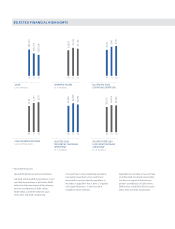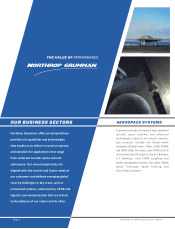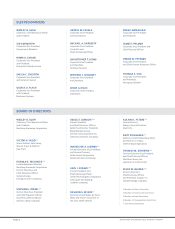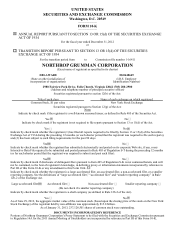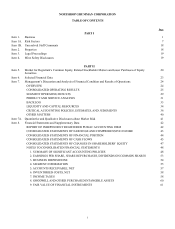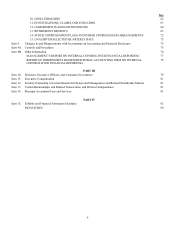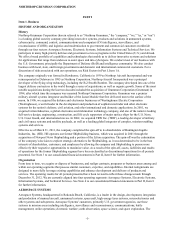Northrop Grumman 2012 Annual Report Download - page 11
Download and view the complete annual report
Please find page 11 of the 2012 Northrop Grumman annual report below. You can navigate through the pages in the report by either clicking on the pages listed below, or by using the keyword search tool below to find specific information within the annual report.NORTHROP GRUMMAN CORPORATION
-1-
PART I
Item 1. Business
HISTORY AND ORGANIZATION
History
Northrop Grumman Corporation (herein referred to as “Northrop Grumman,” the “company,” “we,” “us,” or “our”)
is a leading global security company providing innovative systems, products and solutions in unmanned systems,
cybersecurity; command, control, communications and computers (C4) intelligence, surveillance, and
reconnaissance (C4ISR); and logistics and modernization to government and commercial customers worldwide
through our four sectors: Aerospace Systems, Electronic Systems, Information Systems and Technical Services. We
participate in many high-priority defense and government services programs in the United States (U.S.) and abroad.
We offer a broad portfolio of capabilities and technologies that enable us to deliver innovative systems and solutions
for applications that range from undersea to outer space and into cyberspace. We conduct most of our business with
the U.S. Government, principally the Department of Defense (DoD) and intelligence community. We also conduct
business with local, state, and foreign governments and domestic and international commercial customers. For a
discussion of risks associated with our operations, see Risk Factors in Part I, Item 1A.
The company originally was formed in Hawthorne, California in 1939 as Northrop Aircraft Incorporated and was
reincorporated in Delaware in 1985 as Northrop Corporation. Northrop Aircraft Incorporated was a principal
developer of the flying wing technology, including the B-2 Stealth Bomber. The company developed into one of the
largest defense contractors in the world through a series of acquisitions, as well as organic growth. Some of the most
notable acquisitions during the last two decades included the acquisition of Grumman Corporation (Grumman) in
1994, after which time the company was renamed Northrop Grumman Corporation. Grumman was a premier
military aircraft systems integrator and builder of the Lunar Module that first delivered men to the surface of the
moon. In 1996, we acquired the defense and electronics businesses of Westinghouse Electric Corporation
(Westinghouse), a world leader in the development and production of sophisticated radar and other electronic
systems for the nation’s defense, civil aviation, and other international and domestic applications. In 2001, we
acquired Litton Industries, a global electronics and information technology company, and one of the nation’s leading
full-service design, engineering, construction, and life cycle supporters of major surface ships for the U.S. Navy,
U.S. Coast Guard, and international navies. In 2002, we acquired TRW Inc. (TRW), a leading developer of military
and civil space systems and satellite payloads, as well as a leading global integrator of complex, mission-enabling
systems and services.
Effective as of March 31, 2011, the company completed the spin-off to its shareholders of Huntington Ingalls
Industries, Inc. (HII). HII operates our former Shipbuilding business, which was acquired in 2001 through the
acquisition of Newport News Shipbuilding and a portion of the Litton acquisition. The spin-off was the culmination
of the company’s decision to explore strategic alternatives for Shipbuilding, as it was determined to be in the best
interests of shareholders, customers, and employees by allowing the company and Shipbuilding to pursue more
effectively their respective opportunities to maximize value. As a result of the spin-off, assets, liabilities and results
of operations for the former Shipbuilding segment have been reclassified as discontinued operations for all periods
presented. See Note 3 to our consolidated financial statements in Part II, Item 8 for further information.
Organization
From time to time, we acquire or dispose of businesses, and realign contracts, programs or business areas among and
within our operating segments that possess similar customers, expertise, and capabilities. Internal realignments are
designed to more fully leverage existing capabilities and enhance development and delivery of products and
services. The operating results for all periods presented have been revised to reflect these changes made through
December 31, 2012. We are currently aligned into four operating segments: Aerospace Systems, Electronic Systems,
Information Systems, and Technical Services. See Note 4 to our consolidated financial statements in Part II, Item 8
for further information.
AEROSPACE SYSTEMS
Aerospace Systems, headquartered in Redondo Beach, California, is a leader in the design, development, integration
and production of manned aircraft, unmanned systems, spacecraft, high-energy laser systems, microelectronics and
other systems and subsystems. Aerospace Systems' customers, primarily U.S. government agencies, use these
systems in mission areas including intelligence, surveillance and reconnaissance; communications; battle
management; strike operations; electronic warfare; earth observation; space science; and space exploration. The


